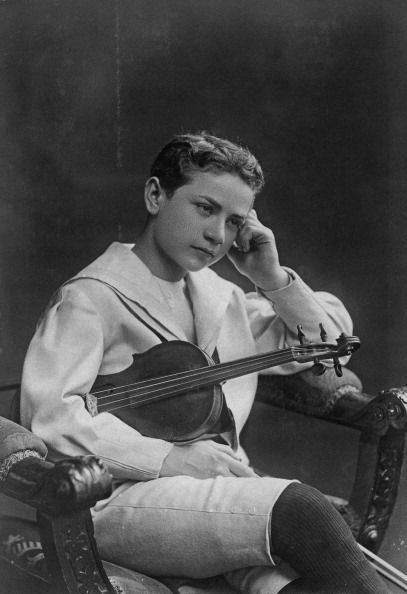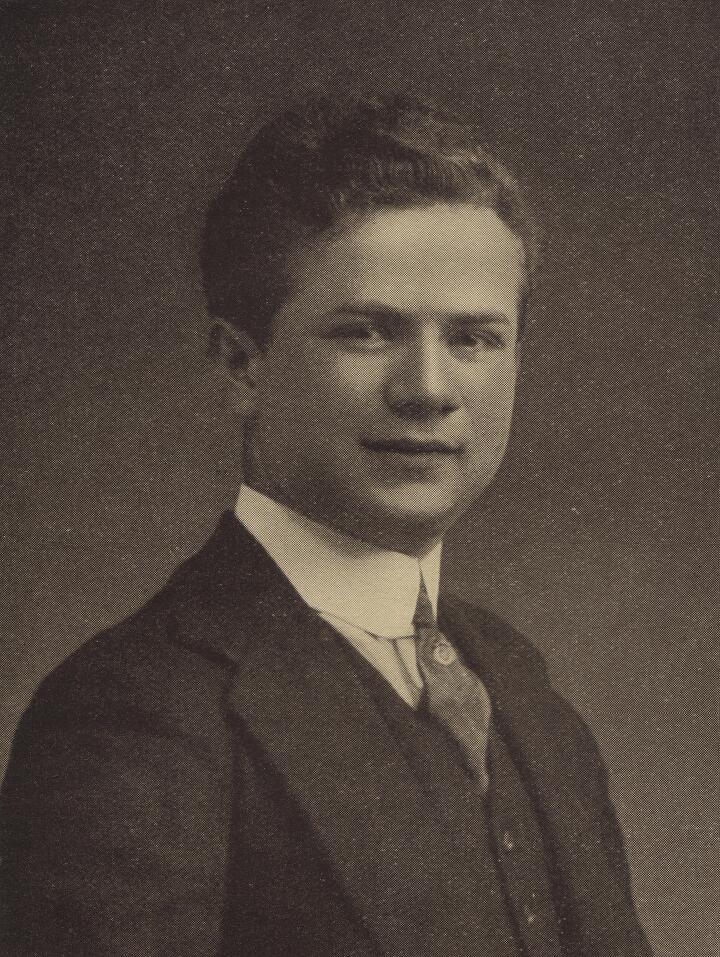

Mischa (Mikhail Saulovich) Elman (Russian: Михаил Саулович Эльман; January 20, 1891 – April 5, 1967) was a Russian-born Jewish-American violinist, famed for his passionate style, beautiful tone, and impeccable artistry and musicality.
Early life
Moses or Moishe Elman was born in the small town of Talnoye (now known as Talne) in the Umansky Uyezd of the Kiev Governorate of the Russian Empire (present-day Ukraine).
His grandfather was a klezmer, or Jewish folk, musician who also played the violin. It became apparent when Mischa was very young that he had perfect pitch, but his father hesitated about a career as a musician, since musicians were not very high on the social scale. He finally gave in, and gave Mischa a miniature violin, on which he soon learned several tunes by himself. Soon thereafter, he was taken to Odessa, where he studied at the Imperial Academy of Music. Pablo de Sarasate gave him a recommendation, stating that he could become one of the great talents of Europe. He auditioned for Leopold Auer at the age of 11, playing the Wieniawski Concerto No. 2 and 24th Caprice by Paganini. Auer was so impressed that he had Elman admitted to the St. Petersburg Conservatory.
Elman was still only a boy when Auer arranged for him to play with the famous Colonne Orchestra during their visit to Pavlovsk. Knowing Édouard Colonne‘s hatred of child prodigies, Auer did not tell him Elman’s age when making the arrangements, and not until the famous conductor saw young Mischa waiting to go on the platform did he realize that he had engaged a child. He was furious, and flatly refused to continue with the programme. Frantic attempts were made to assure him that Elman had the recommendation of Auer himself and was well capable of doing justice to the music, but Colonne was adamant, “I have never yet played with a child, and I refuse to start now,” he retorted. So Elman had to play with piano accompaniment while conductor and orchestra sat listening.” According to Elman .”I was eleven at the time. When Colonne saw me, violin in hand, ready to step on the stage, he drew himself up and said with emphasis: ‘I play with a prodigy! Never!’ Nothing could move him, and I had to play to a piano accompaniment. After he had heard me play, though, he came over to me and said: ‘The best apology I can make for what I said is to ask you to do me the honor of playing with the Orchestre Colonne in Paris.’ He was as good as his word. Four months later I went to Paris and played the Mendelssohn concerto for him with great success.”
Career
In 1903, Elman began to play concerts in the homes of wealthy patrons of the arts, and he made his Berlin debut in 1904, creating a great sensation. His London debut in 1905 included the British premiere of Alexander Glazunov‘s Violin Concerto in A minor. He played in Carnegie Hall in 1908, making a great impression on his American audience. He toured Australia in 1914.Portrait photograph of Mischa Elman, 1915
In 1917, he was elected to honorary membership in Phi Mu Alpha Sinfonia music fraternity. He sometimes performed in as many as 107 concerts in a 29-week season. The Elman family moved to the United States, and Mischa became a citizen in 1923. In 1943, he gave the premiere of Bohuslav Martinů‘s second concerto, which was written for him. Sales of his records exceeded two million.
A frequent accompanist in chamber works during Elman’s early American career was Emmanuel Bay, who was born on exactly the same day as Elman, January 20, 1891. But Elman also performed and recorded with Josef Bonime, Carroll Hollister, Wolfgang Rosé and others, and from 1950, his steady accompanist and recital partner was Joseph Seiger. He also briefly performed and made recordings with the Mischa Elman String Quartet.The headstone of Mischa Elman in Westchester Hills Cemetery
Elman died in his apartment on April 5, 1967 in Manhattan, New York City, a few hours after completing a rehearsal with Seiger He is buried in the Westchester Hills Cemetery in Hastings-on-Hudson, New York.
Legacy
Elman’s recorded legacy spanned more than six decades. His first 78 rpm discs were made for Pathe, in Paris, in 1906; his final LP sessions were for Vanguard, in New York, in 1967. The greater part of his discography was recorded for the Victor Talking Machine Company/RCA Victor, with whom he had an exclusive relationship through 1950. Thereafter, he recorded for Decca/London and later the Vanguard label. Regrettably, Elman’s discs have never been reissued on CD in a systematic manner (whereas almost every recording which his contemporary Jascha Heifetz made has been readily available on CD for years).https://en.wikipedia.org/wiki/Mischa_Elman#References
🙂 ik had een paar van deze voooooor dat jij ze plaatste hier gezet…. we doen veel hetzelfde op ong zelfde moment…. ik zou nu met alles naar buiten gekomen zijn…. wil ik mijn cover foto’s pakken waaraan ik verleden week tijd aan besteede en…. zijn ze weggegooid…. dat is even vreemd opkijken…. ik had eindelijk de nieuwe (nu oude) camera in gebruik genomen en daar had ik proef foto’s op gemaakt…. en… daarna zg goede… en die werden voor proef aangezien…. en dat terwijl mijn opvoeding is…. bespreek eerst de dingen als je iets wil doen/veranderen…..hij voelt het wel….maar het is een hele heisa iemand tot spreken en overleg te krijgen die dat als onderwerping ziet en ook nog van vaders kant uit zo een familie komt… bespreken roept moeilijkheden op dus… dat doe je niet…. en daarmee/door word je dus authoritair… nu ong 23-00 uur…
ik plaats nu deze hier tegelijkertijd als elders wat jij nu ziet… ik hoop dat je wordt of gekrenkt…. ik vind het alleen maar mooi…. die melodie…. die tonen snijden door me heen…. ik ga weer verder met andere dingen….
